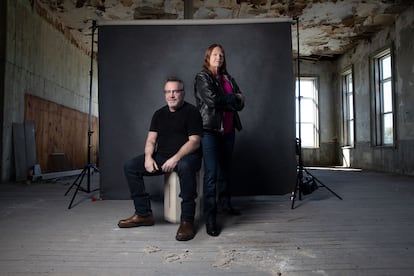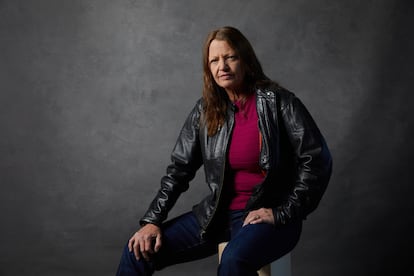‘Queen of Meth’: The rise and fall of a criminal empire in Iowa
Lori Arnold ran a vast drug trafficking empire from a small town in the Midwest. Her brother, the actor Tom Arnold, also tells his side of the story in a documentary about her life as ‘Scarface in a skirt’
Lori Arnold’s arrest on drug-trafficking charges in 1991 made headlines in the United States because her brother, the actor Tom Arnold, was at the time married to one of the most famous women in the country, Roseanne Barr. But in Iowa, it was a different story. In the Midwestern state, Tom was better known for being related to Lori, the “Scarface in a skirt” whose drug empire was eventually worth over $200,000 (€176,000) a week. Lori Arnold’s current partner, a biker called Nick, says that the nickname was an exaggeration: “Lori never wore a skirt.”
When Lori was born in 1961 in the small town of Ottumwa, it advertised itself with the slogan “it could be any city in the United States.” And that is the image that opens a three-part documentary, Queen of Meth, which aired last year on Discovery+ and has just been released on free view channel DMAX in Spain. It is a tale of pure Americanism: both Tom and Lori found the American dream but on very different paths.
“When I was young, I was like, I have to get out of here,” Tom Arnold tells EL PAÍS via telephone. “The meatpacking plant was the best job that everybody [could aspire to] – and that’s a rough job. And people are rough. There’s a lot of violence. There’s a lot of alcohol, drugs. I didn’t have fantastic dreams. I just wanted to be on television and funny once. And I had these dreams that I was friends with [actors] Robin Williams or Arnold Schwarzenegger. I think the biggest difference between us is my sister did not have that. She didn’t have that dream outside of surviving.” But Lori did have dreams, as she makes clear in the documentary: “I was tired of being poor; I deserved something better.”

“When I was 14, my mom gave me speed,” Lori tells EL PAÍS in an email. “I didn’t really think of it like drugs at the time. It kept me up, kept me skinny, felt good. Then, I met my first husband when I was 14 and he was 23. It was a short-lived marriage, but I never got to return to life as a ‘normal’ teenager after that, and that was pretty much the end of my childhood.”
According to Scott Arnold, Lori and Tom’s brother, “Lori’s husband was always charming around me, but I understand there were extracurricular activities,” hinting at abuse. The only delve into Scott’s identity that Queen of Meth makes is that when he was young, he killed a cat by repeatedly running it over with his bike and although all three siblings experienced their own traumas (Tom was sexually abused by a babysitter between the ages of four and seven), all three carry an emptiness left by their mother when she abandoned them.
At that time, the popular joke in Iowa, one of the worst-hit areas by the recession at the end of the 1970s, was that the state’s name was an acronym for “I Only Want Amphetamines.” Judy, one of Lori’s best friends, says that initially she saw amphetamines as the solution to her alcoholism, and then as the answer to her poverty after that. “I was a single mother in the 1980s, I lived on charity and Lori brought me into her business because she loved me. And don’t give me all that crap about money not buying happiness, because it does,” she says in the documentary. Lori bought houses for her friends, set up a ranch with 52 racehorses (which she also doped) and, in a matter of months, the streets of Ottumwa were full of Jaguars, Mustangs and Porsches. The license plate on Lori’s Corvette said DEALER. Her brother sees self-destructive impulses in her opulence.
“When I saw her driving that jet with a dealer license plate, who drives a car like that in our farming town? Absolutely nobody. It takes a lot of nerve to do that. And I just knew, well, you want to get caught obviously,” says Tom. Lori says that her biggest addiction wasn’t drugs, but power and respect, something she was able to see the other side of when she was released from jail in 2000 and moved in with her father. When Tom got her a job at the meatpacking plant, she got a look at what her life could have been like if she had followed the pre-determined path. And it nearly drove her insane. Within months she was dealing again, in two years she had bought another biker bar and she was only prevented from getting back into racehorses because she was arrested. The Federal Bureau of Investigation had told Tom that if Lori stopped dealing immediately, they wouldn’t slap the cuffs on again, but when he passed this on, his sister told him to “mind your own fucking business.” She was the Queen of Meth. She was a somebody.
The brains and the muscle
“Selling came easy to me – I like running shit,” Lori says. “I want people to look up to me, respect me. If anything, I felt empowered, respected, feared, and you feed into that kind of stuff. I was always a badass, I like being a badass. I was the brains, and Floyd was the muscle.” Floyd is Floyd Stockdall, her second husband, a Vietnam veteran who was prone to such violent outbursts at any mention of the war that Lori and Judy could only appease him by putting methamphetamine into his drink. If that is the purest moment of Americanism that takes place in Queen of Meth, a close second is the image of Tom Arnold and Roseanne Barr arriving at the trial in a limousine. “There was no statement,” Tom tells EL PAÍS. “But in that case coming into court, that’s just how it had to – you know, that’s how we had to travel at that time in our life. That’s how we got around. And Roseanne and I had a big life. I miss that private plane. I’ll tell you that right now.”
During her second stint in prison, Tom visited Lori with a television crew. After the decline of his Hollywood career, Tom found small-screen success with The Best Damn Sports Show Period, and thought it could be “kind of fun going to a women’s prison” to film an episode. “And I think it broke the ice with my sister and I for sure.” When Lori got out of jail, the idea for Queen of Meth came about.
The documentary follows all the Hollywood tropes for telling a story of drug dealers: rock n’ roll, desert highways and references to other notorious narcos. When Lori explains that to optimize her distribution network, she decided to hire her own chemist and manufacture meth herself, she says: “Our business basically became Breaking Bad,” in reference to the television series about a chemistry teacher who turns to manufacturing and selling methamphetamine. Even the episode titles of Queen of Meth make references the public will nod to. Daughter of Anarchy (a reference to FX biker drama Sons of Anarchy, in which Tom appeared), The Art of the Dealer – referencing Donald Trump’s 1987 book The Art of the Deal – and To Catch a Queen, a play on Hitchcock’s To Catch a Thief.
Both Tom and Lori have watched a lot of television and know how people who exist in reality TV should behave. The first half of Queen of Meth follows the Hollywood stereotype that dealing drugs is one of the most fashionable, exciting and profitable career choices anyone can make. But the second half of the documentary transforms itself into another type of reality show, one of self-help and self-improvement, which reaches its climax with the siblings confronting their traumas by shouting at their mother’s gravestone. Lori says everything she has been through has made her stronger; Tom insists that she admit her mother ruined her life.
The moral of the story
And finally comes the moral. As if fearing it is glorifying drug dealing, Queen of Meth dedicates a few minutes to the damage Lori’s business left behind. It’s the penultimate stop for Lori, because although she states the drugs were always cut with care (“we wanted people to have a good time, not an overdose,” she says) Queen of Meth needs a moral to legitimize it as televisual content in 2022. Lori is forced to confront the personal (her son grew up with both his parents in jail) and social destruction caused. Ottumwa experienced a generation of orphaned, neglected and traumatized children. Judy says her son has been an addict since he was 17. Lori and Tom are the only people from Ottumwa who appear in the documentary with a full set of teeth.

To tie things off, the production has to pay a visit to the final, obligatory stop in any American tale: redemption. “I think it’s a story about somebody who started with nothing and started basically a new business and then got very successful at it. There’s a lot of negative things that she did, but she succeeded as much as you can succeed in a new and ever-changing business,” says Tom, who concludes the true American dream is “where you do anything and then when you screw up, knock on wood, you get some redemption.”
Today, Lori works as a forklift driver in a warehouse. “Honestly, I’m happy being a ‘normal’ person now. I have a hard job, I’m on my feet for 10-plus hours a day, and it’s tough. But I love the people that I work with, I’m part of a union, I have vacations, a 401k. The Queen of Meth title is not something to be proud of, but it’s something I’ll never get away from. I got out of prison, but I’m doing pretty much a life sentence for selling drugs.”
Tu suscripción se está usando en otro dispositivo
¿Quieres añadir otro usuario a tu suscripción?
Si continúas leyendo en este dispositivo, no se podrá leer en el otro.
FlechaTu suscripción se está usando en otro dispositivo y solo puedes acceder a EL PAÍS desde un dispositivo a la vez.
Si quieres compartir tu cuenta, cambia tu suscripción a la modalidad Premium, así podrás añadir otro usuario. Cada uno accederá con su propia cuenta de email, lo que os permitirá personalizar vuestra experiencia en EL PAÍS.
¿Tienes una suscripción de empresa? Accede aquí para contratar más cuentas.
En el caso de no saber quién está usando tu cuenta, te recomendamos cambiar tu contraseña aquí.
Si decides continuar compartiendo tu cuenta, este mensaje se mostrará en tu dispositivo y en el de la otra persona que está usando tu cuenta de forma indefinida, afectando a tu experiencia de lectura. Puedes consultar aquí los términos y condiciones de la suscripción digital.
More information
Archived In
Últimas noticias
Most viewed
- Sinaloa Cartel war is taking its toll on Los Chapitos
- Oona Chaplin: ‘I told James Cameron that I was living in a treehouse and starting a permaculture project with a friend’
- Reinhard Genzel, Nobel laureate in physics: ‘One-minute videos will never give you the truth’
- Why the price of coffee has skyrocketed: from Brazilian plantations to specialty coffee houses
- Silver prices are going crazy: This is what’s fueling the rally











































